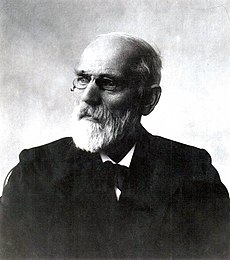
Back Johannes Diderik van der Waals Afrikaans Johannes Diderik van der Waals AN يوهانس ديديريك فان دير فالس Arabic يوهانس ديديريك فان دير فالس ARZ Johannes van der Waals AST Johannes van der Waals Aymara Yan Van-der-Vaals Azerbaijani یوهان دیدریک وان در والس AZB Ян Дыдэрык Ван-дэр-Ваальс Byelorussian Ян Дыдэрык Ван-дэр-Ваальс BE-X-OLD
Johannes Diderik van der Waals | |
|---|---|
 Van der Waals in 1910 | |
| Born | 23 November 1837 Leiden, South Holland, Netherlands |
| Died | 8 March 1923 (aged 85) Amsterdam, Netherlands |
| Alma mater | University of Leiden |
| Known for | Laying the foundations for modern molecular physics (molecular theory) Originating modern theory of intermolecular forces Law of corresponding states Real gas law Van der Waals forces Van der Waals equation of state Van der Waals radius Van der Waals surface Van der Waals molecule |
| Relatives | Joan van der Waals (first cousin, twice removed)[1] |
| Awards | Nobel Prize for Physics (1910) |
| Scientific career | |
| Fields | Theoretical physics, thermodynamics |
| Institutions | University of Amsterdam |
| Doctoral advisor | Pieter Rijke |
| Doctoral students | Diederik Korteweg Willem Hendrik Keesom |
Johannes Diderik van der Waals (Dutch pronunciation: [joːˈɦɑnəz ˈdidərɪk fɑn dər ˈʋaːls] ⓘ;[note 1] 23 November 1837 – 8 March 1923) was a Dutch theoretical physicist and thermodynamicist famous for his pioneering work on the equation of state for gases and liquids. Van der Waals started his career as a schoolteacher. He became the first physics professor of the University of Amsterdam when in 1877 the old Athenaeum was upgraded to Municipal University. Van der Waals won the 1910 Nobel Prize in Physics for his work on the equation of state for gases and liquids.[2]
His name is primarily associated with the Van der Waals equation of state that describes the behavior of gases and their condensation to the liquid phase. His name is also associated with Van der Waals forces (forces between stable molecules),[3] with Van der Waals molecules (small molecular clusters bound by Van der Waals forces), and with Van der Waals radii (sizes of molecules). James Clerk Maxwell once said that, "there can be no doubt that the name of Van der Waals will soon be among the foremost in molecular science."[4]
In his 1873 thesis, Van der Waals noted the non-ideality of real gases and attributed it to the existence of intermolecular interactions. He introduced the first equation of state derived by the assumption of a finite volume occupied by the constituent molecules.[5] Spearheaded by Ernst Mach and Wilhelm Ostwald, a strong philosophical current that denied the existence of molecules arose towards the end of the 19th century. The molecular existence was considered unproven and the molecular hypothesis unnecessary. At the time Van der Waals's thesis was written (1873), the molecular structure of fluids had not been accepted by most physicists, and liquid and vapor were often considered as chemically distinct. But Van der Waals's work affirmed the reality of molecules and allowed an assessment of their size and attractive strength. His new formula revolutionized the study of equations of state. By comparing his equation of state with experimental data, Van der Waals was able to obtain estimates for the actual size of molecules and the strength of their mutual attraction.[6]
The effect of Van der Waals's work on molecular physics in the 20th century was direct and fundamental.[7] By introducing parameters characterizing molecular size and attraction in constructing his equation of state, Van der Waals set the tone for modern molecular science. That molecular aspects such as size, shape, attraction, and multipolar interactions should form the basis for mathematical formulations of the thermodynamic and transport properties of fluids is presently considered an axiom.[8] With the help of the Van der Waals's equation of state, the critical-point parameters of gases could be accurately predicted from thermodynamic measurements made at much higher temperatures. Nitrogen, oxygen, hydrogen, and helium subsequently succumbed to liquefaction. Heike Kamerlingh Onnes was significantly influenced by the pioneering work of Van der Waals. In 1908, Onnes became the first to make liquid helium; this led directly to his 1911 discovery of superconductivity.[9]
- ^ Mel Voet (May 16, 2019). "Plots ging het licht schijnen" (in Dutch). Mare. Archived from the original on May 26, 2019.
- ^ "The Nobel Prize in Physics 1910". Nobel Foundation. Retrieved October 9, 2008.
- ^ Parsegian, V. Adrian (2005). Van der Waals Forces: A Handbook for Biologists, Chemists, Engineers, and Physicists. (Cambridge University Press), p. 2. “The first clear evidence of forces between what were soon to be called molecules came from Johannes Diderik van der Waals's 1873 Ph.D. thesis formulation of the pressure p, volume V, and temperature T of dense gases.”
- ^ Johannes Diderik van der Waals - Biographical - Nobelprize.org
- ^ van der Waals; J. D. (1873). Over de continuiteit van den gas- en vloeistoftoestand (On the Continuity of the Gaseous and Liquid States) (doctoral dissertation). Universiteit Leiden.
- ^ Sengers, Johanna Levelt (2002), p. 16
- ^ Kipnis, A. Ya.; Yavelov, B. E.; Rowlinson, J. S.: Van der Waals and Molecular Science. (Oxford: Clarendon Press, 1996)
- ^ Sengers, Johanna Levelt (2002), pp. 255–256
- ^ Blundell, Stephen: Superconductivity: A Very Short Introduction. (Oxford University Press, 1st edition, 2009, p. 20)
Cite error: There are <ref group=note> tags on this page, but the references will not show without a {{reflist|group=note}} template (see the help page).